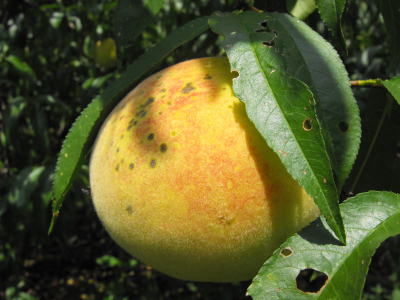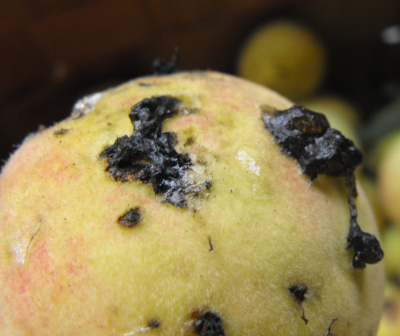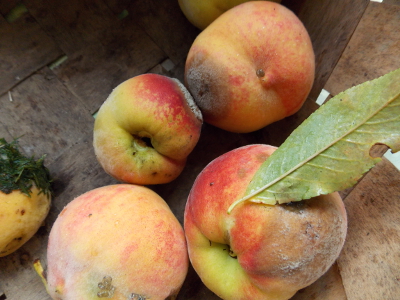
Fighting brown rot
 "I have a nectarine tree that fruits like crazy but the fruit rots every
time before a single fruit can be harvested. The tree just seems sickly
and I'm thinking I might just have to remove it. However, I was watching
a video by Alex Ojeda and he said he dug a circle around a sickly lemon
tree, placed sticks and such in the trench, and recovered it with the
dirt (in essence, creating an "after the fact" hugelkulture). Have you
ever tried this (I know you planted your trees in hugelkultures but it's
too late to do that with this tree)? If so, would I dig the circle at
the drip line or further in? And would it help with the fruit issue or
is that just a fungus issue (I was hoping if the tree was healthier, it
could fight off the fungus better, if that is the problem)? Thanks for
any help you can give."
"I have a nectarine tree that fruits like crazy but the fruit rots every
time before a single fruit can be harvested. The tree just seems sickly
and I'm thinking I might just have to remove it. However, I was watching
a video by Alex Ojeda and he said he dug a circle around a sickly lemon
tree, placed sticks and such in the trench, and recovered it with the
dirt (in essence, creating an "after the fact" hugelkulture). Have you
ever tried this (I know you planted your trees in hugelkultures but it's
too late to do that with this tree)? If so, would I dig the circle at
the drip line or further in? And would it help with the fruit issue or
is that just a fungus issue (I was hoping if the tree was healthier, it
could fight off the fungus better, if that is the problem)? Thanks for
any help you can give."
I'm afraid that what you're likely looking at is brown rot,
the bane of peaches, nectarines, and other stone fruits in the humid
South. While boosting a tree's health with hugelkultur is always a
good idea, it's unlikely to prevent this kind of fungal disease if your
weather conditions are right for it. We battle brown rot pretty
hard, and after a few years of trial and error, these are my top tips:
- Plant resistant varieties. Unfortunately, most nectarines are more susceptible to brown rot than peaches are (and even peaches get it pretty bad). We ended up cutting down our nectarine because it seemed to be a disease magnet.
- Prune your trees high and open.
If I could go back in time, I'd change my pruning strategy so the
scaffold branches didn't come off the tree lower than three feet above
the ground. Brown rot is produced by a fungus, fungi like damp,
and the ground is always the dampest spot. I am happy with my
open-vase form, though, since that lets sunlight penetrate the whole
tree and dries fruits quickly once the rain stops.
 Try to manage insect pests that damage fruits. Brown rot usually enters fruits through tiny holes created by insects, in our case by the Oriental fruit moth.
I do my best to manage Oriental fruit moth populations by cutting off
damaged twigs and soaking them in water to drown the insects, but I only
have moderate success with this.
Try to manage insect pests that damage fruits. Brown rot usually enters fruits through tiny holes created by insects, in our case by the Oriental fruit moth.
I do my best to manage Oriental fruit moth populations by cutting off
damaged twigs and soaking them in water to drown the insects, but I only
have moderate success with this.
- Thin fruits optimally.
Brown rot also thrives where two fruits butt up against each other as
they swell. If you're careful to thin your tree so every bloom is
at least six inches from another, you'll prevent this damp, fungus-prone
location.
 Monitor your tree daily starting a couple of weeks before full ripe. By
pulling off any fruits that have borderline brown rot, you can keep the
fungus down to a dull roar. And picking good fruits once the ground
color shows ripeness, but before they're soft, allows you to ripen them
inside, beyond the fungal zone.
Monitor your tree daily starting a couple of weeks before full ripe. By
pulling off any fruits that have borderline brown rot, you can keep the
fungus down to a dull roar. And picking good fruits once the ground
color shows ripeness, but before they're soft, allows you to ripen them
inside, beyond the fungal zone.
All of that said,
hugelkultur certainly won't hurt. If you live in a damp location
(which I assume you do if you're having trouble with brown rot),
you don't really even need to dig a trench. Just toss a bunch of
wood, one layer thick, on the soil surface around the drip line.
As the wood rots, the tree roots will grow up to claim the
nutrients. Good luck!
Want more in-depth information? Browse through our books.
Or explore more posts by date or by subject.
About us: Anna Hess and Mark Hamilton spent over a decade living self-sufficiently in the mountains of Virginia before moving north to start over from scratch in the foothills of Ohio. They've experimented with permaculture, no-till gardening, trailersteading, home-based microbusinesses and much more, writing about their adventures in both blogs and books.
Want to be notified when new comments are posted on this page? Click on the RSS button after you add a comment to subscribe to the comment feed, or simply check the box beside "email replies to me" while writing your comment.

Hi Anna and Mark and all,
Sick trees is a good subject.
Mostly what I see is: plant is sick, spray with this or that. At lots of $$ with no change.
Somehow the question of what is not in the soil is NEVER asked.
This year I picked lots of perfect apples from a tree in a public space.
So for me the question is what WAS in that soil. Well, that tree was near LOTS of bark mulch. Probably had lots of fungi active and feeding that tree?
If you look at what cures humans and animals, you get the idea that the lack of certain minerals is most probably the cause ( and the 'cure'.). The long term absence of iodine causes cancer. It appears that certain old anti-biotics cure autism and related diseases in VERY small irregular doses. See Dr. Thomas McPherson Brown's protocol.
So maybe you are the one to discover how to cure trees?
So for me a good soil test and adding lthings like: seawater (fresh), seaweed (fresh), granite dust and sea shells. Not products bought in bottles or bags makes the most sense.
Take a look at Korea Natural Farming and their IMO and OHN and add these. Maybe some 'charged' biochar. Acres USA is a good resource for these and many other ideas.
Please let us know how you cured your tree, so we can add your method to our lists. It sounds like you are asking the right questions !!
!!
warm regards, John
Thanks so much for the blog post, Anna! We live about an hour west of Asheville - so a very similar climate to your homestead, just warmer. And we had a wet summer, just like you.
I learned about brown rot from another post you had and have wondered if that's what my tree has but the fruit doesn't look anything like the photos you have. The tree will get very small nectarines all over - very lovely - and then they rot and shrivel up, almost like a raisin! Every year it produces abundantly and every year they shrivel up before they're anywhere close to picking.
I will try the mulching/tree branches around the drip line. Thank you also, John, for the tips. I'm curious - why seawater? I have heard of the other additions, but not that one.
Karyn --- Thanks for those extra details! There are several other potential fungal diseases, but brown rot might still be the culprit. I'm careful to cull peaches very early in the rot stage, because by the time they start shriveling up, they've produced spores to spread the disease far and wide. But if you leave them alone, they do produce "mummies" that look like gray raisins. You might try running a google image search for "brown rot", and maybe also just for "peach disease" and "peach mummy" and some other similar keywords. That's often how I diagnose new problems nowadays.
John will probably chime back in, but I'm assuming the seawater would be to provide micronutrients like the his other suggestions.
Two things have worked for me:
1) As you do, I bring peaches in just before ripe. Usually mine take 2-4 days to ripen indoors on the counter once I pick them. I still lose some to brown rot inside but it is much reduced. This also helps with deer, if an issue, because they seem more interested in peaches that are fully ripe on the tree.
2) Prune heavily in the off-season. Brown rot infects wood, as well. Sometimes with a brown-rotted peach you can see that the adjacent leaves have yellowed and the twig has turned black, also. Larger branches can have cankers. This all needs to be removed or it will serve as a reservoir of infection in the next year. Also carefully clean the ground for mummified remains of last season's rotted peaches.
Something else: Brown rot spreads fast, but if you see a peach with a relatively small part brown-rotted, the rest is often still sweet and edible. This probably sounds gross. I cut away any browned tissue and then some, but will sometimes use the rest. If you can, you'll be subjecting the peaches to high temps anyway.